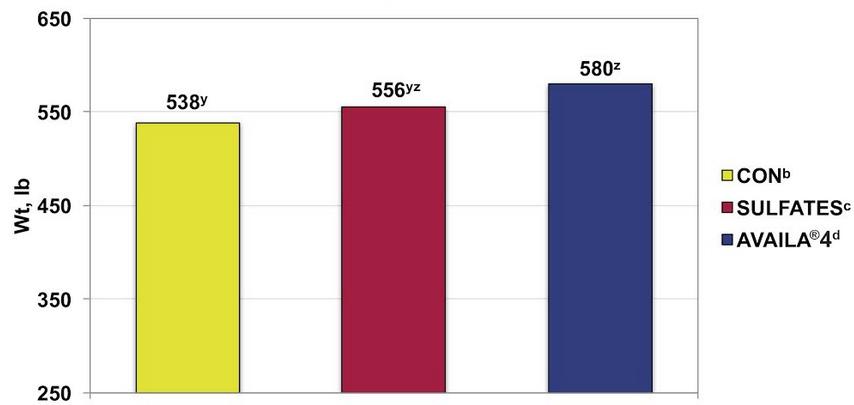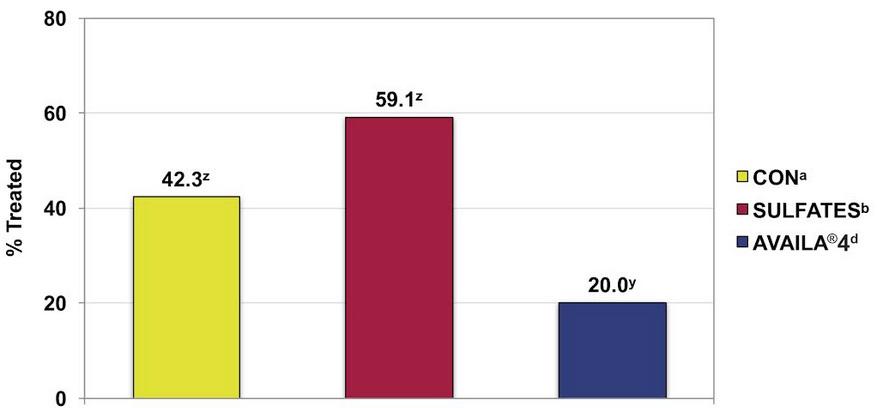
2 minute read
Giving Calves a Great Start Begins With Cow Nutrition

By: Connie Larson, Ph.D., Research and Nutritional Services Ruminant Manager - North America, and Jason Russell, Ph.D., Beef Research Nutritionist, Zinpro Corporation
As the cattle industry continues to produce and promote the value of beef as a protein source to meet nutritional demands of an increasing population, beef production practices will evolve to impact calf lifetime performance. Feed yard managers recognize that incoming cattle with compromised immunity impact their bottom line whether the animals will be challenged with respiratory disease or infectious claw lesions creating lameness issues.
Information evaluated from 47,764 head enrolled in the Iowa Tri-County Steer Test over an eight-year period revealed that cattle requiring just one treatment had decreased performance. These steers had lower out-weights, longer days on feed and less desirable feed conversion that contributed to $68 per head loss on profitability compared to steers that required no health treatment. For steers requiring two or more treatments, the losses escalated to over $189 per head. In order to minimize these losses, it is apparent that pre-arrival health, nutrition and handling are critical factors for optimizing feed yard performance and ultimately carcass characteristics. In other words, how do we get calves off to a great start?
The first opportunity begins prior to the birth of a calf. Nutritional interventions to promote fetal programming in beef cattle are a growing area of interest in the cow-calf segment of our industry. Most often, the conversation about fetal programming focuses on the impact of energy and protein intake during gestation. However, an arguably under-discussed concept is Generational Nutrition®, the impact trace minerals can have on offspring development, health and performance.
Trace minerals are essential for fetal development and the fetus depends entirely on the dam for proper supply of these elements. If maternal supply is inadequate or imbalanced, fetal development and post-natal performance may be impaired. For example, Zn, Cu, Mn and Co are required for adequate development of the fetal nervous and immune systems that set the stage for future performance in achieving the genetic potential of our cattle today.
A recent study conducted at Oregon State University evaluated the response of offspring to different trace mineral supplementation programs for late-gestation beef cows. At the end of the second trimester of gestation Angus X Hereford cows were supplemented with either no additional zinc, manganese, copper or cobalt (Control), inorganic (sulfate) forms, or Availa®4 (7 grams per head daily). The Availa-4 and inorganic supplements were formulated to provide equal trace mineral fortification. As cows calved, the cow-calf pairs were returned to the general herd and fed a common diet containing sulfate-based trace minerals.
Key Research Findings:
Results support Generational Nutrition and the influence of trace mineral programs on in utero calf development and subsequent growth and immunity. Weaning weights were greatest for calves from cows fed Availa-4 during the last trimester of pregnancy. The 205-adjusted weaning weights for calves from dams fed the control, inorganic or Availa-4 treatments were 538 pounds, 556 pounds and 580 pounds, respectively (Figure 1).
Following a 45-day preconditioning program, the calves were trucked to a commercial grow yard. Calves born to cows supplemented with Availa-4 continued to have an advantage as fewer calves required treatment for BRD symptoms. Treatment rates for calves from dams fed control, inorganic or Availa-4 treatments were 42, 59 and 20 percent, respectively (Figure 2).

Calves born to cows fed a diet that included Availa-4 maintained a weight advantage through harvest. Hot carcass weights were 42 and 22 pounds greater for calves from dams fed Availa-4 versus calves born from cows fed the control or inorganic treatments, respectively.

Supplementing Availa-4 during a cow’s last trimester appears to have set the stage during fetal development for offspring to optimize growth potential for weaning weights, require fewer treatments for BRD and produce heavier carcass weights. As the cattle industry navigates new regulations with the Veterinary Feed Directive, nutrient support for optimum immunity to minimize respiratory disease and infectious claw lesions will likely gain greater attention. While continued research efforts are needed to further determine the impact of Generational Nutrition, the future is promising.










